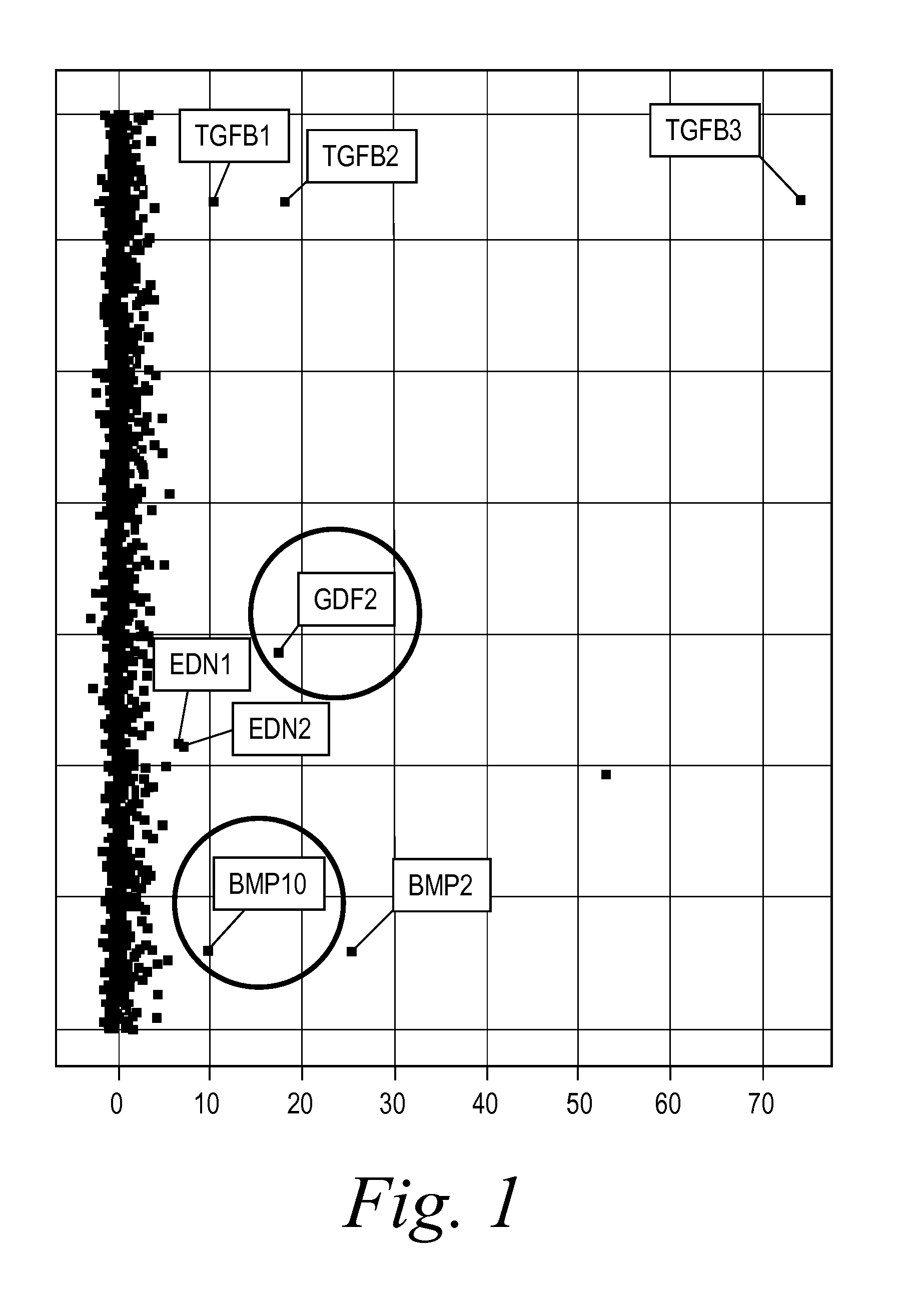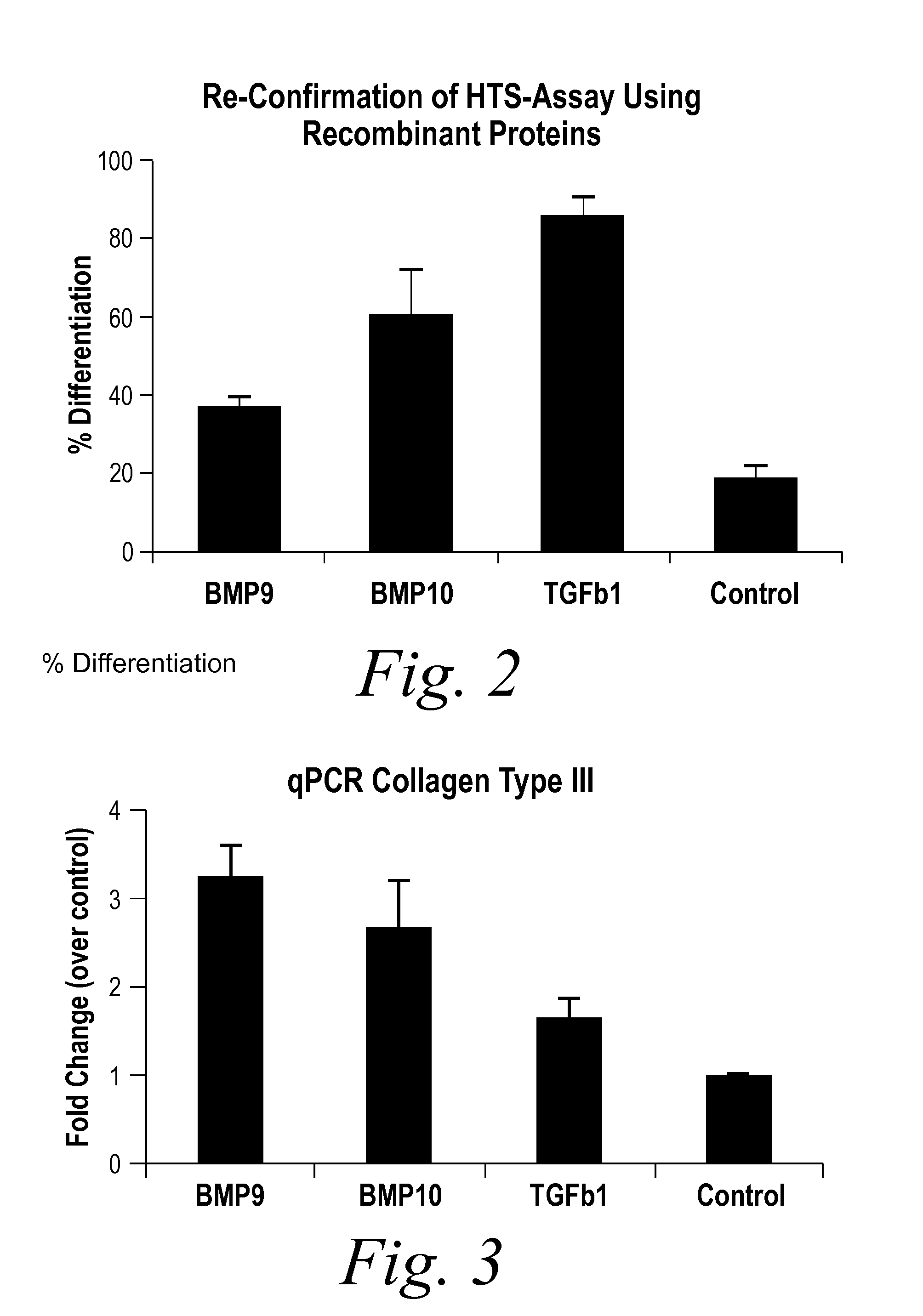Diagnostic BioMarkers for Fibrotic Disorders
a biomarker and fibrotic disease technology, applied in the direction of biological material analysis, peptides, tissue culture, etc., can solve the problems of affecting tissue or organ function, and affecting the detection of bmp9 and/or bmp10. the effect of facilitating the detection of bmp10
- Summary
- Abstract
- Description
- Claims
- Application Information
AI Technical Summary
Benefits of technology
Problems solved by technology
Method used
Image
Examples
example 1
[0235]BMP9 and BMP10 were identified as indicators of fibrosis in a phenotypic screen and, therefore, as potential therapeutic targets capable of treating fibrotic disorders. The experiment was performed in 384 well plate format and in triplicate. Briefly, a reverse transfection in Hek293 cells of approximately 1500 human cDNA expression clones encoding predicted secreted proteins was performed using Fugene 6 (Roche) at a ratio of 4:1 (Fugene:DNA) in complete DMEM (Invitrogen) medium. Hek293 cells were washed 24 hours post transfection and incubated for an additional 48 hours to enrich for secreted proteins. Conditioned media from the transfected Hek293 cells were transferred onto human primary dermal fibroblast at passage 3 (Lonza) that were synchronized by starvation for 24 hours in absence of serum. The differentiation of fibroblast into myofibroblast was scored 96 hours later by immunostaining for the presence of alpha smooth muscle actin (αSMA [Sigma], a known marker of fibrobl...
example 2
[0237]To further assess the role of BMP9 in fibrosis, a reporter gene assay (RGA) was established. Specifically, a BMP9 reporter construct (ID-BRE) was generated using Id1 promoter BMP-response element (BRE) fused with firefly luciferase gene. The BMP9 RGA was conducted on HEK293 cells stably transfected with ID-BRE. HEK293 ID-BRE cells were seeded at 5×105 cells / 35 mm-dish one day before transfection. 2.5 μg DNA constructs of constitutively active ALK1 and GFP (10:1) were co-transfected into HEK293 ID-BRE cells via Fugene 6 (Roche, 8 μl), followed by manufacturer's protocol on day 2. Transfection efficiency was measured by visualization of GFP. Transfected cells were then seeded into 96-well plate at 1×104 cells / well on day 3. BMP9 was added to the 96-well plate at different concentration with or without a BMP9 neutralizing antibody or a soluble receptor, ALK1-Fc, on day 4. Cells were harvested on day 5 and luciferase activity was measured using Bright-Glo Luciferase Assay System (...
example 3
[0238]An Epithelial-Mesenchymal Transdiferentiation (EMT) assay was performed to assess whether BMP9 has any effect on EMT in hepatocytes. Specifically, Hep3B cells (ATCC) were cultured in DMEM-F12, supplemented with 10% FBS, 10 U / ml penicillin, and 10 U / ml streptomycin, at 37° C. in a humidified atmosphere containing 5% CO2. 2×105 Hep3B cells were seeded in complete DMEM-F12 into each well of 24-well plates.
[0239]The medium was replaced with low serum (1%) medium with or without 10 ng / ml of BMP9 (R&D).
[0240]In one experiment, the cells were fixed 24 hours post-treatment with or without BMP9, fixed for image analysis and subjected to immunohistochemistry staining with E-cadherin and α-SMA. As evidenced by the cell morphological changes depicted in FIG. 6, BMP9 induced EMT, decreased E-cadherin and increased α-SMA, as compared to the control.
[0241]For quantitative PCR analysis, the cells were harvested 48 hours post-BMP9 treatment and the total RNA was extracted and subjected to RT-P...
PUM
| Property | Measurement | Unit |
|---|---|---|
| half life | aaaaa | aaaaa |
| molecular weight | aaaaa | aaaaa |
| concentration | aaaaa | aaaaa |
Abstract
Description
Claims
Application Information
 Login to View More
Login to View More - Generate Ideas
- Intellectual Property
- Life Sciences
- Materials
- Tech Scout
- Unparalleled Data Quality
- Higher Quality Content
- 60% Fewer Hallucinations
Browse by: Latest US Patents, China's latest patents, Technical Efficacy Thesaurus, Application Domain, Technology Topic, Popular Technical Reports.
© 2025 PatSnap. All rights reserved.Legal|Privacy policy|Modern Slavery Act Transparency Statement|Sitemap|About US| Contact US: help@patsnap.com



